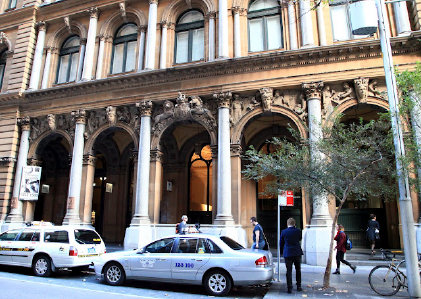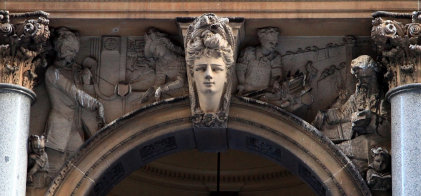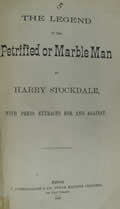
Contact

Home
The Sydney Morning Herald (NSW)
Date: June 3, 1889
Page Number: 9
TO THE EDITOR OF THE HERALD.
Sir, - It is just possible that the "petrified man" lately discovered near Orange may have been the handiwork of a gentleman of the name of Nicholls, a sculptor, who visited Sydney about 1853. He was a superior artist, and I remember him saying that he had visited that neighbourhood, and that he had seen some marble of a superior sort, fit for sculpture. I met him afterwards at the Liverpool Town Hall, in England. He was then at work doing some statues for the hall.
He left here in about 1855.
I am, &c, I
June 1. W. M. WALLIS.
The Argus (Melbourne, Vic.)
Date: June 3, 1889
Page Number: 6
A number of medical men and others decline to accept the dictum of the Government geologist regarding the supposed petrified man found in a marble quarry near Orange. Several well-known experts declare that the specimen is beyond doubt what it is asserted to be, while others incline to the contrary opinion, and quite an animated controversy is going on the subject.
THE MARBLE MAN
The Sydney Morning Herald (NSW)
Date: June 3, 1889
Page Number: 9
TO THE EDITOR OF THE HERALD.
Sir, - The theory of rude carving may be put aside at once, also the theory of hoax, unless we concede that a skilful workman has obtained a corpse, with the arms cut off, one eyeball missing, and three toes, and has made a cast of this mutilated corpse for the purpose of deceit. I think this theory will not stand, because the circumstances would be so unusual, and because of the difficulties involved in the casting of the mould and recasting of the statue, and the absurdity of applying such a process to a mutilated body. My theory is that the man was a runaway convict, who had probably been living with the blacks, and had adopted their habits, the body being entirely naked. The head is large, with great power and ferocity. He had lost one eyeball during life, and one leg was slightly thinner than the other, possibly the effect of leg-irons. Three toes on the left foot and the side of the foot itself are missing, perhaps broken in getting it out. Theorising as to how the body came there, it seems to me probable that, being caught in a thunderstorm, he lay down under an overhanging ledge on his back, and, placing his hands under his head, went to sleep. The storm of rain loosening the earth above him, it fell upon him, and hermetically sealed him up. The water charged with lime was injected through the body, and the petrifaction became complete. If anyone doubts the possibility of this process taking place in a short time - geologically speaking - I can prove the contrary by a specimen of petrified wood in my office, which has become completely metamorphosed since 1837 at all events. But the records of petrification extend to very much shorter periods. I now approach (very gingerly) the one puzzle to me, viz., the missing arms. The armpits show conclusively that the arms were turned upwards. Dr. M'Carthy thinks they were sawn off. Query : Was the man killed as he lay, and were his arms sawn off for food by his mates, or did they find him dead and then saw them off for convenience of burial or for food, or have they been broken off when the body was shifted by the water ? Let doctors decide these points. I say shifted by water because it appears to me that the fall of earth on him contained pebbles. One in particular appears to have pressed the lips apart at one corner, and I understand from the quarryowner that after moving six or seven tons of marble boulders, the body was found in a bed of lime. Other observers considered that he had been speared by blacks in the mouth and elsewhere. If so, they might have hung him up alive and flung spears at him till he died. But I don't think that would be the way of the Australian black. At all events this body will furnish much food for discussion. If it be determined as the work of a sculptor, we can only regret that such a supreme artist should have lived and died unknown, and that he should have had a fancy to carve such a fragmentary work, instead of our great men. Particularly would I direct attention to the exquisite carving of the toe-nails and the change of material, which looks like polished glass, and exhibits the difference between the petrifaction of flesh and that of horn, if it be not a sculpture.
I am, &c.,
June 1. W. LOVEGROVE.
MacCarthy, Charles William (1848–1919)
Cultural Heritage: Irish
Religious Influence: Catholic
Surgeon, Irish Nationalist, composer, painter, sculptor (self-taught).

The Sydney Morning Herald (NSW)
Date: June 4, 1889
Page Number: 5
TO THE EDITOR OF THE HERALD.
Sir,--There is no doubt the discoverer or proprietor of the "petrified man" has had fortune smiling upon him, the more especially seeing that he has obtained so much useful and good advertising for nothing, doubtless also to the decided benefit of his pocket This advertising is still continued briskly by the help of the geologists, anatomists, and all sorts of scientists. Dr. M'Carthy has taken the matter up with zeal and contends with great scientific ardour for the correctness of his judgment that the discovery is that of a bona fide fossil. The geologist of our Mines Department, who went to inspect this wonder, after carefully viewing it, declared it to be no petrifaction, but simply a clever piece of rough sculpture, and consequently a hoax. We have the best of all letters that have yet appeared in our daily papers on this subject signed by a Mr. W. Lovegrove. His opinion as to the nature of this exhibit is the same as that of Dr. M'Carthy, but he also gives a sensational hypothesis as to how the supposed unfortunate being came by his death. This petrified man was once a runaway convict overtaken by a thunder- storm (a storm something: like that we had last week).
The great fall of rain prepared him a soft tomb, then water and earth covered him up. But not satisfied with this theory Mr Lovegrove ventures on another, even more sensational, by giving this poor wretch into the hands of our aboriginals, who hang him "alive" and then spear him until he is dead , but he seems not to cherish this second idea, as he thinks that our blacks had no taste for such kind of performances.
Dr. M'Carthy renews the warfare to-day, and no doubt gives plenty of very good reasons, which seem to render any other theory impossible from a scientific standpoint, unless a portion of this man is obtained for purpose of analysis Dr. M'Carthy has been fortunate enough to have been allowed to inspect most fully the petrified man. The geologists of the Mines Department were not granted this privilege, they were only permitted to view the front of the figure, and I was amongst many others who were deprived of full and particular examination of the discovery. But, as my opinion as to the nature of the alleged petrified man is such a different one from that of others, it will matter very little to discuss the correctness of the anatomical formation of any part of it, also as to the presence of the usual limestone formations associated with petrifications. It will also be unnecessary for me to enter into discussion of any other scientific conclusion, as I simply propose to give a kind of prescription as to how one can produce a petrified man, as having viewed this figure once only, without the opportunity of full inspection. I base my version first upon my knowledge of marbles and sculpture, secondly on previous experience of such discoveries. For making a proper petrified man I should go to Italy - say Florence, Rome, or Naples - and purchase from an antiquary a petrified man, which will be sold to you as genuine. If not easily obtained I would visit one of those artists who seldom model anything else but "real" antiquities, and procure a model from him. From this I should make a mould, and with the finest of alabaster plaster produce a cast of this petrified man - this could be done even at Orange. Obtain from Elliott Brothers a certain quantity of acids, then immerse this man, which, when taken out after a few hours, would be much harder than marble. You may place this petrified man into his grave covered properly with mud or anything else you like, leaving his toes out of the ground, so as to attract the curiosity of a boy , after such discovery I should move the petrified man to Park-street or anywhere else and charge 1s. per head to any one that might want to see my wonder, until the police stop me on the accusation of obtaining money under false pretences.
However strange my prescription or theory may scorn, I hope that eventually it will be found I am correct, and of course if it is proved that this petrified figure is nothing but a plaster cast, the presence of veins, incrustations, or any other hard veins, will be easily explained. When imitations of this sort are fabricated, the mould is carefully indented and traced in order to receive temporarily such hard substances which will necessarily be incrusted on the cast when turned out, and give the imitation a genuine appearance.
I am, &c.,
June 3. , OSCAR MEYER.
THE MARBLE MAN
The Sydney Morning Herald (NSW)
Date: June 4, 1889
Page Number: 5
TO THE EDITOR OF THE HERALD.
Sir,--I am a sculptor of 40 years' experience, and not writing good English, I dictate my ideas on the petrified man to a friend, who puts them into proper words. Having carefully examined the specimen, I have no doubt it is a genuine petrifaction. I shall state my reasons: -
1. Considered from a sculptor's stand- point, the general proportions of the body are correct, showing the unmistakable correctness of nature, not art.
2. The position, the pose of the limbs and flattening of the parts pressed on, as well as the muscular forms, show it to be a dead body, all these indications being perfectly natural.
3. The pittings on the surface are not such as would be produced by chisel or other tool marks.
4. I would easily detect tool marks, no matter how the specimen would be treated and no matter what its age. No acid, no sand no rubbing, or treatment of any kind would obliterate them sufficiently to prevent detection Of course I am speaking of rough chiselling, which should be employed to give the pitted appearance which the specimen has.
5. Any person attempting to do this body in the rough state, would necessarily, when coming to open between the thighs and legs, leave the horizontal and other markings of the pick.
6. Where the knees, thighs and heels are webbed, the tool-markings would be plainly perceptible but every body can that see those webbings are done by nature, and it occurs to me it must have taken a long time for nature to effect this.
7. With rough chiselling, and without the use of an instrument called the violin (which would necessitate help), in all probability the work would break many times. The left leg would certainly be
broken, as it contains what we sculptors know as "a hair," that is a part where union has not taken place in the calcareous formation. This continued breaking of the work, and in fact the general difficulty in fashioning the body would also arise from the fact (a fact which struck me forcibly from a professional point of view) that the body rests on no base or back support all its parts being given minutely all around.
8. This work could never be done in all its correctness in proportions, in general form, accurate pose, and corpse like appearance, without, as Dr. M'Carthy has pointed out, the cast of a dead body in the same position, and effected in a similar way by pressure, posture &c., and then it could easily be recognised as an imposition.
I am, &c,
LUIGI DEL VESCOVO, Sculptor. June 3.


Italian-born sculptor Tomaso Sani, along with Luigi del Vescovo, was responsible for the controversial basso-relievo carvings on Sydney's General Post Office in 1883:



Oscar Meyer (1851-?)
Cultural Heritage: Italian
Religious Influence: Protestant
On leaving school Mr. Meyer for several years travelled about the continent acquiring a considerable knowledge of European languages and an acquaintance with the art of Europe which has stood him in good stead since.
Thomas Nicholls - English sculptor.
(1825-?)

___________________
Lovegrove, William
Cultural Heritage: Scottish (?)
Religious Influence: Anglican (?)
Co-founder of the Illawarra Steam Navigation Company, engineer, President of the local Agricultural Association, artist, musician, painter.
The Marble Man part 2








